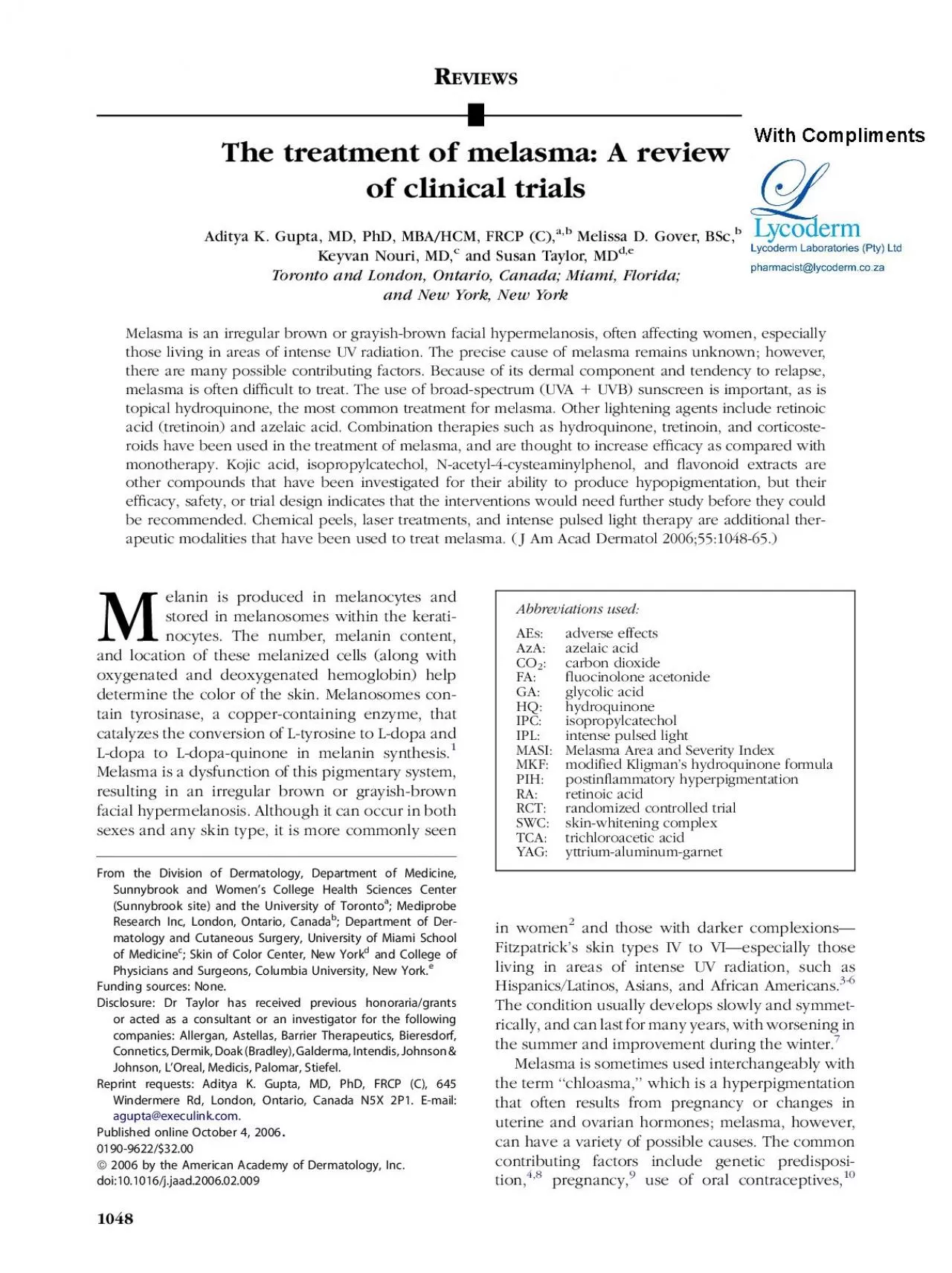

REVIEWS AbbreviationsusedAEsadverseeffectsAzAazelaicacidcarbondioxideFAfluocinoloneacetonideGAglycolicacidHQhydroquinoneIPCisopropylcatecholIPLintensepulsedlightMASIMelasmaAreaandSeverityInd ID: 944120
Download Pdf The PPT/PDF document "ThetreatmentofmelasmaAreviewofclinicaltr..." is the property of its rightful owner. Permission is granted to download and print the materials on this web site for personal, non-commercial use only, and to display it on your personal computer provided you do not modify the materials and that you retain all copyright notices contained in the materials. By downloading content from our website, you accept the terms of this agreement.
REVIEWS Thetreatmentofmelasma:AreviewofclinicaltrialsAdityaK.Gupta,MD,PhD,MBA/HCM,FRCP(C),a,bMelissaD.Gover,BSc,KeyvanNouri,MD,andSusanTaylor,MDTorontoandLondon,Ontario,Canada;Miami,Florida; Abbreviationsused:AEs:adverseeffectsAzA:azelaicacid:carbondioxideFA:fluocinoloneacetonideGA:glycolicacidHQ:hydroquinoneIPC:isopropylcatecholIPL:intensepulsedlightMASI:MelasmaAreaandSeverityIndexMKF:modifiedKligmanÕshydroquinoneformulaPIH:postinflammatoryhyperpigmentationRA:retinoicacidRCT:randomizedcontrolledtrialSWC:skin-whiteningcomplexTCA:trichloroaceticacidYAG:yttrium-aluminum-garnet endocrinedysfunctionorhormonetreatments,andexposuretoUVlight.Inaddition,cosmeticsanddrugscontainingphototoxicagents(eg,antisei-zuremedications)havealsobeenlinkedtome-Interestingly,Wolfetalsuggeststhatsomecasesofmelasmacouldbestressinduced,becausethereleaseofmelanocyte-stimulatinghormonecanbeinfluencedbystress.Whenmelasmaoccurswithpregnancy,alsotermedÔÔthemaskofpregnancy,ÕÕitcanresolvewithinafewmonthsafterdeliveryandtreatmentmaynotbenecessary.However,therearemanycasesinwhichthedisorderpersistsindeÞnitely.Pregnancy-associatedmelasmamaybecausedbyanincreaseinplacenta,ovarian,andpituitaryhormones.lasmahasalsobeenattributedtoanelevationofmelanocyte-stimulatinghormone,estrogen,andpro-gesteroneleadingtoincreasedmelanogenesis.Vazquezetalreportsthatmelasmainmensharesthesameclinicohistologiccharacteristicsasinwomen,withtheexceptionthathormonalfactorsmaynotplayamajorrole.Themainassociatedfac-torsamongmenappeartobesun-inducedaggrava-tionandasignificantfamilyhistoryofthecondition.AstudyofmelasmainIndianmenimplicatedsunexposureandcosmeticuseincludingtopicalmus-tardoil.Itishelpful,beforetreatment,toperformanexaminationusingWoodÕslamp;thiswillidentifythedepthofthemelaninpigmentation,thus,helpingtodelineatethetypeofmelasma.Generally,me-lasmaisclassifiedintooneof3histologictypes:epi-dermal,dermal,andmixed.However,somealsoincludeafourthtypeknownasWoodÕslightinap-parent.UnderWoodÕslighttheepidermaltypeoftenshowsadarkeningofcolorwhenexamined,asthelightemittedbyWoodÕslampisabsorbedbytheexcessmelanin.Thedermaltype,however,willnotshowthisaccentuation.ThemixedtypeinvolvesadepositionofmelanininboththeepidermisandthedermisandcolorenhancementwithWoodÕslightisseenissomeplacesoftheskin,butnotothers.Itisinterestingtonotethatwhenhistologicallyassessing56patients,Kangetaldidnotfindanycasesofentirelydermal-basedmelasma.Further-more,Sanchezetaldescribedermaltypeme-lasmaashavingmelanin-ladenmacrophagesintheperivasculararray,bothinthepapillaryandretic-ulardermis.Epidermalhyperpigmentationinthedermaltypewasfoundtobesimilartotheepider-maltype,butnotasprominent.Ithas,thus,beensuggestedthattheremaybenotrulypuredermaltypeofmelasma.Thereare3clinicalpatternsrecognizedonthebasisofclinicalexamination.Theseincludeacentrofacial,malar,andmandibularpattern.Thecentrofacialisthemostcommonpatternofmelasmaandinvolvesthecheeks,forehead,upperlip,nose,andchin.Themalarpatternhaslesionslimitedtothecheeksandnose,andthemandibularpatternhaslesionsthatoccurovertheramusofthemandible.Othersites(eg,forearmandneck)mayalsobeinvolvedinanyofthesepatterns.MEDLINE(1966-2005)wassearchedusingthekeywordsmelasma,chloasma,hyperpigmentation,andhypermelanosis.Thisarticleoutlinespublishedran-domizedcontrolledtrials(RCTs)oftheinterventionsthathavebeenstudiedforuseinthetreatmentmelasma.WhenRCTswerenotpresent,nonrandom-izedoropenclinicaltrialswerereviewed.GeneralmanagementBecauseofitsrefractoryandrecurrentnature,melasmaisoftendifÞculttotreat.Thegoalsoftreatmentoftenincludepreven
tionorreductionintheseverityofrecurrence,reductionoftheaffectedarea,improvementinthecosmeticdefect,andre-ducedtimetoclearance,allwiththefewestpossiblesideeffects.Theprinciplesoftherapyincludepro-tectionfromUVlight,inhibitionofmelanocyteactivityandmelaninsynthesis,andthedisruptionandremovalofmelaningranules.Generalmanagementrecommendationsthatassistintheclearingofmelasmaincludediscontinu-ationofbirthcontrolpills,scentedcosmeticproducts,andphototoxicdrugs,coupledwithUVprotectionwithuseofbroad-spectrum(UVAUVB)sun-screens.Solarexposureexacerbatesmelasma,anditsavoidanceisfundamentalforthesuccessfulman-agementofthedisease.Mostpatientsusingbleach-ingagentscanexpectarecurrenceofthediseaseonexposuretosunlightandartificialUVAandUVBThissupportstheimportanceoftheuseofbroad-spectrumsunscreens(SPF(SPF30)inmelasmatherapies.Broad-spectrumsunscreensmustbeap-plieddailythroughouttheyearandcontinuedindef-initelytominimizethereactivationofmelanocytesbyincidentalexposuretothesun.Althoughsunscreensareavitallyimportantcom-ponentoftherapy,otherformsoftreatmentarenonethelessnecessary.Topicaltreatmentsincludetheapplicationofcreamssuchashydroquinone(HQ).Althoughsomenegativereactionshavebeendescribed,HQremainsoneofthemostprescribedagentsformelasmaandisconsideredthegoldstandardoftherapy,especiallyforepidermalme-lasma.Theepidermaltypegenerallyhasagoodresponsetotopicaltherapy,whereasskinwithERMATOL55,NGuptaetal mainlydermaldepositionofmelaninrespondsAlternativetherapiessuchaschemicalpeel-ingagentsorlasertherapyaresometimesalsoused.TableIoutlinesthevarioustreatmentsformelasmaandtheirproposedmechanismofaction.TableIIoutlinesefficacystudiesforthemostcommonformsoftopicaltreatment,whereasTableIIIfocusesontheefficacystudiesforchemicalpeelingagents.HydroquinoneMechanismofaction.HQ(1,4-dihydroxyben-zene)isahydroxyphenol,which,inthepresenceofcatalyticamountsofdopa,willcompetewithtyro-sine,thenaturalsubstrateoftyrosinase.Thisprocesspreventstheenzymaticoxidationoftyrosinetodopa,thus,preventingthesynthesisofmelanin.Thisisconsistentwiththeselectivemodeofactiontowardcellswithactivetyrosinaseactivity.EfÞcacy.AmerandMetwalliassessedtheeffi-cacyofHQ4%creamusedinconjunctionwithbroad-spectrumsunscreeninpatientswithvariouspigmentarydisorders.Ofthe70patientsenteredintothestudy,50hadmelasma,10freckles,and10postinflammatoryhyperpigmentation(PIH).Thepigmentintensityrelativetononaffectedareasofskinwasdeterminedona4-pointscalewith1beingnodifference,2mildpigmentation,3moderatepig-mentation,and4severepigmentation.Fromweek0to12(treatmentend)thenumberofpatientswithmelasmaandmoderatepigmentationdecreasedfrom28(56%)to1(2.1%),andpatientswithseverepigmentationdecreasedfrom22(44%)to4(8.4%).Inaddition,thenumberofpatientswithmelasmawithnodifferencebetweenaffectedandnonaffectedareasincreasedfromnoneatweek0to41patients(85.4%)atweek12.Thestudydeemedthattherewasagoodtoexcellentresponseachievedin89.5%ofpatientswithmelasmaandthattreatmentwithHQisbeneficialinpatientswithhyperpigmentarydisor-However,theseresultsshouldbeconsideredwithcaution,asthisstudyisnotrandomizedorplacebocontrolled.Furthermore,thestudyseemstolackadetaileddescriptionofthemethodsunder-takenandthereappearstohavebeennostatisticalanalysisoftheresults.Haddadetalinadouble-blind,randomized,placebo-controlledstudyof30patientswithme-lasma,assessedtheefficacyofaskin-whiteningcomplex(SWC)5%creamversusHQ4%cream.Patientswererandomizedintotwogroups;group1receivedHQ4%andplacebo,andgroup2receivedSWCandplacebo,eachtobeappliedtooppositesidesoftheface.Efficacywasmeasuredbasedontwoindependent
investigatorevaluationsandapatientquestionnaire.Ofthe30patientsenrolled,25completedthestudy.Group1(HQvsplacebo)showedanimprovementof76.9%andgroup2(SWCvsplacebo)showedanimprovementof66.7%.Thisdifferencewasnotstatisticallysignificant(FisherÕs=.673).Patientsatisfactionlevelswere66.7%forgroup1and69.2%forgroup2.DespitebeingaRCT,thisstudyoptstoevaluatethecompoundsinvolvedthroughamorequalitativeapproach,ratherthanusingmeasuresofpigmentintensityorMelasmaAreaandSeverityIndex(MASI)scores.Furthermore,thestudyfailstoprovideadescriptionofwhatcomprisesSWC.Nonetheless,witha76.9%improve-mentrateinthosetreatedwithHQ,thisstudydoessupportearlierevidencethatHQiseffectiveintreatinghyperpigmentation.Interestingly,whiletestingglycolicacid(GA)peelsformelasma,Hurleyetaldiscoveredthat4%HQmonotherapywithdailyapplicationofsun-screennotonlyimprovesmelasma,butisaseffectiveastheirproposedpeelingregimenplusHQ.Inthisrandomized,investigator-blind,split-faceprospec-tivetrial,21Hispanicwomen(18ofwhomcom-pletedthestudy)weretreatedwith4%HQand4GApeels(20%concentrationonfirsttwovisitsthen30%atnexttwo)ononesideand4%HQonlyontheother.Bothsideshadastatisticallysignificanttreat-menteffect(.001).However,betweenthetwogroups,therewasnosignificantdifferenceineitherthedegreeofpigmentationlighteningorintheMASIscoresfrombaselinetotreatmentend.HQ4%creamasamonotherapywasconcludedtobeanadequateagentfortreatingmelasma.TheavailableconcentrationsofHQvaryfrom1.5%to4%(TableIV).Concentrationsof2%orlessareavailableintheUnitedStatesinover-the-counterpreparationsandthosewithconcentrationsgreaterthat2%areavailableonlybyprescription.Inthe TableI.ThemechanismsbywhichvarioustreatmentsformelasmaachievetheirdepigmentingeffectMechanismofactionTherapyTyrosinaseinhibitorHydroquinoneAzelaicacidKojicacidNonselectivesuppressionofmelanogenesisInhibitionofROSAzelaicacidRemovalofmelaninChemicalpeelsThermaldamageLasertreatments,Reactiveoxygenspecies.*Tretinoinmayalsodispersekeratinocytepigmentgranulesandaccelerateepidermalturnover.Guptaetal TableII.StudiesinvolvingcommonlyusedtopicalagentsforthemanagementofmelasmaNo.ofpatientsTreatmentStudyDesignECR1R2DurationResultsSunscreenVazquezetalR,DB5953Sunscreen3moR1:96.3%showedHQHQR2:80.8%showedNosignificantbetweenR1andR2.HQAmeretalO50HQ4%12wkGoodtoexcellentresponsein89.5%ofthosewithmelasma.etalR,DB,3025HQ4%vsSWC5%vs3moR1:improvementof76.9%onHQside.R1=15R1=12R2:improvementof66.7%onSWCside.R2=15R2=13TretinoinGriffithsetalR,DB5038Tretinoin0.1%Vehicle40wkR1:68%improved;significantoverbaseline(=.0003).R1=26R1=19R2:5%improved.R2=24R2=19Epidermalpigmentreducedby36%inR1,butincreasedby50%inR2(=.002).GreenetalR,DB3028Tretinoin0.1%Vehicle40wkR1:73%improved.R1=15R1=15R2:46%improved;15%worsened.R2=15R2=13R1marginallysignificantbetterthanR2=.07).SteroidNeeringR,O1716Betameth-3moDepigmentationin12patients,attributedtobetamethasone25%ShowednoCombinationGanoetalO20Tretinoin0.05%valerate0.1%10wk65%Showed35%ShowednoHQ2%etalR,SB641HQ4%Tretinoin0.05%FA0.01%HQ4%0.05%or0.01%orHQ4%8wkSignificantlymorepatients(28.6%)inR1clearedSignificantlymorepatients(77%)R1completeclearingAzALoweetalR,DB,5245AzA20%Vehicle24wkR1:treatmentresponsein55%ofpatients.R1=25R1=21R2:treatmentresponsein12.5%.R2=27R2=24 ERMATOL55,NGuptaetal treatmentofmelasma,itisrecommendedthattheHQpreparationsbeapplieduniformlyandtwicedailytotheaffectedarea.Ithasbeenrecommendedthatifnoimprovementisevidentafteraninitial2monthsofuse,thenthedrugshouldbediscontinued;however,insomecasesitcantakeaslongas6monthsforachangetoappear.Safetyandtolerability.Themostfrequentlyobserv
edreactionsaremildskinirritationandsen-sitization,characterizedbyitching,burning,stinging, TableII.ContdNo.ofpatientsTreatmentStudyDesignECR1R2DurationResultsetalR,DB155132AzA20%HQ2%24wkR1:56.9%achievedgoodoverallimprovement;16.9%excellent;23%fair.R1=77R1=65R2:17.9%good;1.5%excellent;50.8%fair;29.8%treatmentfailures.R2=78R2=67R1differedsignificantlyfromR2(etalR,DB329243AzA20%HQ4%24wkR1:64.8%good/excellentoverallresult;7.4%treatmentfailures.R1=164R1=122R2:72.5%good/excellent;8.3%R2=165R2=121NosignificantdifferencebetweenR1andR2.etalR,DB,6559AzA20%HQ4%24wkR1andR2equivalentoverallscores;noR1=31R1=29GA15%-20%GAvehicleR2=34R2=30KAGarciaetalR,O,3939KA3mo51%Hadequalreductionwithbothregimens.GAGA28%HadmorereductionwithR1.21%HadmorereductionwithR2.R1andR2notdifferent((.05).Lim(1999)R,DB,4340KA2%HQ2%12wkR1:morethanhalfclearancein60%ofcases.HQ2%GA10%R2:morethanhalfclearancein47.5%ofcases.GA10%Improvementnotdifferent(=.9).,Azelaicacid;,completed;,double-blind;,enrolled;,flucinoloneacetonide;,glycolicacid;,hydroquinone;,kojicacid;,open;,parallelgroup;,randomized;,regimen1;,regimen2;,right/leftcomparison;,single-blind;,split-face;,skin-whiteningcomplex.*Thestudyenrolled70patientswithvariouspigmentarydisorders,only50possessedmelasma.Guptaetal andallergicdermatitis,andhavebeenreportedtooccurmorefrequentlywith4%than2%concentra-tions.ChronicuseofhighconcentrationsofHQ5%)havebeenreportedtoproduceochronosisandcolloidmilium.InthestudybyAmerandMetwalli,localirrita-tionwasnotedinmostpatients,butexogenousochronosiswasnotobserved.Therandomized,controlledstudybyHaddadetalreportedthattheincidenceofsideeffectswasgreateramongtheHQgroupthantheSWCgroup,where25%oftheHQgroupreportedanitchyeruption.ThiswasnotstatisticallysignificantfromtheSWCgroup,whichhadnoreportsofsideeffects.Bentley-PhillipsandBaylesconducteda6-yearinvestigationdesignedtoassessthesafetyofHQincosmeticskin-lighteningproductsandtodetermineanoptimalconcentration.Throughtheuseofopenandclosedpatchtestingof840volunteers(resultingin7000testareas)theydeterminedthatHQisasuitableforuseincosmetics,providedthatthecontentiskeptbelowacertainlimit.HQ3%concen-trationwasdeterminedtobetheoptimalstrength.Interestingly,theirimpressionfromclinicalobserva-tionswasthatmanyofthesideeffectsexperiencedmayoccurfrommisuse,excessiveuse,andtheappli-cationofmultiplepreparations.Ithasalsobeensuggestedthatpatientsmayuseunsuitablecleansingagents,carryoutvigorousrubbingoftheaffectedareas,andapplyexcessiveamountsofmedication.TretinoinMechanismofaction.Retinoids,suchasvita-minAacidandretinoicacid(RA)ortretinoin,were TableIII.StudiesinvolvingchemicalpeelsusedinthemanagementofmelasmaNo.ofpatientsTreatmentStudyDesignECR1R2DurationResultsGALimetalSB,R/L1010SerialGAGA10%26wkR1:6patientshadslightlighteningofmelasma(independentassessorevaluation);4hadGA10%HQ2%R2:7hadslight;1hadmoderate;2showednochange.HQ2%etalO25233GApeels50%3moImprovementobservedin91%(3mo(follow-up)etalR,SB,21181GApeel20%HQ4%BothR1andR2sidesshowedsignificanttreatmenteffectcomparedwithcontrol1GApeel30%NosignificantdifferenceinMASIscoresbetweenR1andR2.HQ4%etalO,PI4040GApeelsMKF21wkR1hadsignificantlybetterresponsethanR2(R1=20R1=20R2=20R2=20SAGrimesPI62SApeelsHQ4%R1resultedinmoderatetosignificantimprovementin4of6patientswithmelasma.3SApeelsHQ4%TCAChunetal20TCApeels55%ofthosewithmelasmaexperiencedagoodclinicalresponse.,Completed;,enrolled;,glycolicacid;,hydroquinone;,MelasmaAreaandSeverityIndex;,modifiedKligmansHQformula;,open;,pilotinvestigation;,randomized;,regimen1;,regimen2;,right/leftcomparison;,salicylic
acid;,single-blind;,split-face;,trichloroaceticacid.*Thestudyenrolled25patientswithvariousdermatologicdisorders,only6possessedmelasma.Thestudyenrolled106patientswithvariouspigmentarydisorders,only20possessedmelasma.ERMATOL55,NGuptaetal TableIV.ProductsavailableinNorthAmericacontaininghydroquinoneastheactiveingredientVehicleConcentrationNameOTCCream1.5%EsotericaUnscented,MedicisCanadaLtdEsotericaSensitiveSkin,Medicis1.8%DrulaFadeCreamMedium-Medicated,Drula-Fabrik,Dr.O.DruckeryGMBH2%BanishingCream2%,AvonCanadaIncCremeBlanchissante2%,Dr.DanielProductsEldopaqueCream2%,ICNCanadaLtdEldopaque,ValeantEldoquinCream2%,ICNCanadaLtdEldoquin,ValeantEsotericaFacialCream,MedicisCanadaLtdEsotericaRegularCream,MedicisCanadaLtdEsotericaSunscreenFadeCream,MedicisCanadaLtdEsotericaRegularwithpapabenspropyleneglycolandsodiumbisulfite,MedicisEsotericaFacial,MedicisEsotericaSunscreen,MedicisObagiProtocolsClear,ObagiMedicalProductsIncPalmersSkinSuccessFadeCream,E.T.BrowneDrugCoIncSeequin2IDS,VivierCanadaIncSolaquin2%Cream,ICNCanadaLtdSolaquin,ValeantUltraplusSkinLighteningCream2%,UltracareLaboratoriesIncVantexSkinBleachingCreamwithSunscreen2%,FashionFairCosmeticsLotion2%ClairissimeClearComplexionLotion,AyotaiCanadaIncFadingFluid,FlageoliLimitedRodanandFieldsProactivSolution:SkinLighteningLotion,GuthyRenkerCorpGel2%ConditioningGel,LaboratoiresLaRoche-PosayCanadaNeostrataHQAHAGel2%,CandermPharmaIncPrescriptionSolution3%Melanex,NeutrogenaMelquin-3,StratusHydroquinoneSolution,GladesCream4%DrulaFadeCreamSuperforteMedicated,Drula-Fabrik,Dr.O.DruckeryGMBHEldopaqueForteCream4%,ICNCanadaLtdEldopaqueForte,ValeantEldoquinForteCream4%,ICNCanadaLtdEldoquinForte,ValeantGlyquinXM,ICNCanadaLtdHydroquinoneCream,Ethex,GladesHydroquinonewithSunscreens,Ethex,GladesLustra,Taropharma,ADivisionOfTaroPharmaceuticalsIncLustra-AF,Taropharma,ADivisionOfTaroPharmaceuticalsIncMelpaqueHP,StratusMelquinHP,StratusNeostrataCanadaHQPlusCream,CandermPharmaIncNuquinHP,StratusSolaquinForte4%Cream,ICNCanadaLtdSolaquinForte,ValeantUltraquinCream4%,CandermPharmaIncUltraquinPlainCream4%,CandermPharmaIncViquinForteWithMoisturizingAHA-Cream,ICNCanadaLtdViquinForte,ValeantGel4%HydroquinoneForteGel,GladesNeostrataCanadaHqPlusGel,CandermPharmaIncNuquinHP,StratusSeequin4IDS,VivierCanadaIncSolaquinForte,ValeantUltraquinGel4%,CandermPharmaInc,Overthecounter.Guptaetal ÞrstusedincombinationwithHQtoenhancethepenetrationofHQ,butwerelaterrecognizedtohavetheirowneffectonthepigment.TretinoinÕsabilitytodepigmentisbasedonitsabilitytodispersekeratinocytepigmentgranules,interferewithpig-menttransfer,andaccelerateepidermalturnoverand,therefore,pigmentloss.Inaddition,thereisalsoevidencethatitcaninhibittheinductionoftyrosinase,DOPAchromeconversionfactor,andmelanogenesis.EfÞcacy.GrifÞthsetalrandomized50Caucasianwomen(38ofwhomcompletedtreatment)withfacialmelasmaintoa40-weekstudyoftopical0.1%tretinoinversusvehicle.Efficacywasassessedbasedonoverallclinicalresponse,gradedonascalerangingfrom(muchworsethanbaseline)to2(muchimproved).Thecolorofmelasmawasgradedas3muchdarkerthanbaseline,2darker,1slightlydarker,0nochange,1slightlylighter,2lighter,and3muchlighter.OverallseverityunderWoodÕslightwasassessedonascalewhere0wasnomelasma,1to3wasmild,4to6moderate,and7to9severemelasma.Colorimetryandhistologicanalysiswerealsoperformed.Inthetreti-noin-treatedgroup,68%(13of19)wereratedasimprovedormuchimproved,versus5%ofthevehiclegroup.Reductionofoverallseverityinthetretinoingroupwassignificantlygreaterthanthevehiclegroup=.0003).Furthermore,tretinoinsignificantlylight-enedarea
sofmelasmatoavalueof1.50.3U,butthevehicle-treatedareaswereactuallydarkenedtoavalue0.1U(.0001).Theseresultswereconsistentwiththeresultsofcolorimetry,whichalsoshowedlighteningwithtretinoinanddarkeningwiththevehicle.Histologyshowedthatepidermalpigmentwasreducedby36%aftertretinointreatment,buttherewasa50%increasewiththevehicle.Kimbrough-Greenetalrandomized30AfricanAmericanpatients(28ofwhomcompletedtreat-ment)withmoderatetoseveremelasmaintoadouble-blind40-weekstudyinvolving0.1%tretinoincreamversusvehicle.Atstudyend,theaverageMASIscoreforthetretinoingroupdecreasedby32%;thevehiclegroupexperienceda10%decrease.Overallresponseatweek40wasonlymarginallystatisticallysignificantcomparedwithvehicle(=.07).Ofthe15(73%)patientstreatedwithtretinoin,11werecon-sideredimprovedormuchimproved,whereas6of13(46%)patientsusingvehicleimproved.Noclinicalworseningwasobservedwithtretinoin,but15%ofpatientsusingvehicleratedasworseattrialend.Colorimetricanalysisrevealeda40%lighteningtowardnormalskincolorwithinthetretinoingroup,comparedwitha4%lighteninginthevehiclegroup.Histologicanalysisindicatedthattretinointherapyproducedan8%decreaseinepidermalpigmentation,whereastherewasa55%increasewiththevehicle.Tretinoinisavailablein3forms:gel,cream,andliquid,atstrengthsrangingfrom0.01%to0.1%andisapprovedforthetreatmentofacnevulgarisandphotoaging.27,34Asamonotherapyitisnotanap-provedtreatmentformelasma;however,itispartofacombinationHQ,tretinoin,andfluocinoloneaceto-nide(FA)cream(Tri-Luma,Galderma,FortWorth,Tex)whichisanapprovedtreatmentformelasma.Safetyandtolerability.Themostcommonsideeffectsoftretinoinincludearetinoiddermatitischar-acterizedbyburningorstinging,erythema,scaling,anddryskin.Giventhattretinoincanbeirritating,thedosemustbeadjustedtopreventinflammation.Thisinflammationmaycausehyperpigmentation,especiallyinthosewithdarkskin.Fortunately,mostadverseeffects(AEs)arereversibleondiscontinua-tionoftherapy,althoughthehyperpigmentation/hypopigmentationmaypersistformanymonths.CutaneousreactionsreportedbyGrifÞthsetalwereconsideredmoderatein88%ofpatientstreatedwithtretinoinand29%ofthosereceivingvehicle.In5members(20%)ofthetretinoingroupthereactionwasconsideredtobesevere(grade4);thiswasnotseenwiththevehicle.Kimbrough-Greenetalreportedthatcutaneousreactionswerelimitedtoerythema,peeling,orbothoftheareaofapplicationandwereobservedin67%(10of15)ofthepatientstreatedwithtretinoinandinonepatienttreatedwithvehicle.Thesideeffectswerecharacterizedasgen-erallymildandresultedinnopatientwithdrawals.Nopatientexperiencedhyperpigmentation.Thosesensitivetoacitretin,etretinate,isotreti-noin,orothervitaminAderivativesmayalsobesensitivetotretinoin.Inaddition,patientsusingvitaminAacidcanalsobeatanincreasedriskforsunburnandaremoresusceptibletoirritationfromwind,cold,anddryness.Topicaltretinoinisnotconsideredmutagenicorcarcinogenic,however,animaltestshavedemonstratedevidenceforterato-genicity.Therehavenotbeenadequateandwell-controlledstudiesperformedinpregnantwomen.Inaddition,thesafetyoftretinoingelhasnotbeenestablishedinchildrenyoungerthan12years,nei-therhasthesafetyoftheemollientcreaminpatientsyoungerthan18years.CorticosteroidsMechanismofaction.Ithasbeensuggestedthatcorticosteroidsmaydirectlyaffectthesynthesisofmelanin,althoughthemechanismbywhichtheskinislightenedisnotcompletelyknown.Melano-cytesrespondtoavarietyofchemicalmediatorssuchasprostaglandinsandleukotrienesand,thus,ithasERMATOL55,NGuptaetal beentheorizedthatsteroidsmightaltermelano-cytefunctionbyinhibitionofprostaglandinorcytokineproductionbyvariouscellsoftheepi-dermis.Corticos
teroidsmaysuppresssecretorymetabolicproductsfrommelanocyteswithoutcausingtheirdestruction,andthiscouldbethereasonfortheirshort-livedeffectonpigmentationdisorders.EfÞcacy.Theuseofcorticosteroidsinthetreat-mentofmelasmaisseenmoreofteninconjunctionwithothertopicaltherapies(eg,tretinoinandHQ).Asamonotherapytherehasbeenlittlepublishedresearch,resultinginonlytwosmall-scalestudies.investigatedbetamethasone17-valerate0.2%,twice-dailyapplicationfor3months,asamonotherapyformelasma.Inthisrandomized,dou-ble-blind,split-facestudyof15patientswithme-lasmaandonewithsecondarypigmentation,therewasasignificantdepigmentationeffectfrombeta-methasone(.05).Agradualdepigmentationwasnotedin12patients,where9patientsachievedagoodimprovementand3displayedamoderateimprovement.Fourpatientshadnodepigmentation.Unfortunately,thestudyfailedtoassesswhethertheimprovementcausedbysteroidtreatmentwasalong-termbenefit.Inalettertotheeditor,Kanwaretaloutlinedthetreatmentof10patientswithmelasmaandthetopicalcorticosteroidclobetasolpropionate(0.05%),report-ingfadingofpigmentationafter2weeks,with80%to90%clearanceofpigmentobservedin7patientsafteronly6to8weeks.Thisinitialclearanceofpigmentwas,however,shortlived,lastingatmaximum6monthsandinsomeonlyacoupleofweeks.Safetyandtolerability.Withsteroidusepatientscandeveloparosacea-likeeruptionwithpersistenterythema,pustules,andpapulesinacentrofacialdistribution(whichcanßarewhenste-roidiswithdrawn,butthenclearafter1-3months).Perioraldermatitis,seenpredominatelyinadultwomen,isalsopossible.Occasionallyandparadox-ically,corticosteroids,whichareoftenusedtotreatallergicdisorders,canthemselvesproduceallergiccontactdermatitis.Neeringnotedthatthesideeffectswithbetamethasoneconsistedmainlyofanitchingsensation.Atrophicchangesareacommonlyencounteredsideeffect.Eveninasmall-scalestudy,suchasthatofKanwaretal,3patientshadtoceasetreatmentafter4weeksbecauseoflocalatrophyandtheappearanceoftelangiectasiasafterapplicationofclobetasonepropionate0.05%.However,inthetrialwithbetamethasone,atrophywasnotseen.Be-causeofatrophyandothersideeffects,monother-apywithtopicalsteroids,especiallyhigh-potencysteroids,formelasmaisnotarecommendedthera-peuticoption.Combinationtherapy:HQ,tretinoin,andasteroidAneffectivetreatmentforepidermalhypermela-nosisisacombinationofHQ,asteroid,andtretinoin.Thecombinationstronglyinhibitstheproductionofmelaninwithoutthedestructionofmelanocytes.KligmanandWillisproposedapreparationcon-tainingHQ5%,tretinoin0.1%,anddexamethasone21-acetate0.1%,tobeapplieddailyfor5to7weeks,anditwasfoundtobeeffectiveinthetreatmentofmelasma.Inaddition,theydiscoveredthatomittinganyonecomponentresultedinalossofeffective-ness.Loweringtheconcentrationsofthecompo-nentsdecreasedthefrequencyofirritancy,butalsodecreasedthepotencyofthemixture.Despiteitseffectiveness,thispreparationcontainshighconcen-trationsoftretinoinandHQ,andusesdexametha-sone,whichisapotentfluorinatedsteroid.Overtheyearsthiscombinationhasbeenalteredtoobtainaformulationwithlessseveresideeffects,whilemaintainingorimprovingefÞcacy.Ganoandtreatedmelasmawithtretinoin0.05%,beta-methasonevaleratecream0.1%,andHQcream2.0%for10weeksandfounda65%improvement.ThesideeffectswerefrequentbutminimalinseverityandthetreatmentwasconsideredtobesuccessfulevenduringthespringandearlysummerwhenthereisanincreaseinUVlightexposure.Pathaketalevaluatedtreatmentregimensthatincluded2%to5%HQcreams,withorwithout0.05%or0.1%RA,appliedtwicedailyfor3months.Theenhancedpigment-producingactivityofmelanocyteswasbestdiminishedbytheavoidanceofsunlightandtheuseofthecombinationformulacon
taininglowconcen-trationsofHQandRA.Morerecently,Tayloretal,with641patients,investigatedtheeffectsof4%HQincombinationwith0.05%tretinoin(RA),and0.01%FA.Thiscom-bination(Tri-Luma)iscurrentlyapprovedintheUnitedStatesforthetreatmentofmelasma.Thismulticenter,randomized,investigator-blind,8-weektrialfoundthatsignificantlymoreofthepatientstreatedwithRA,HQ,andFA(77%)experiencedcompleteornearcompleteclearingwhencomparedwitheachofthedualtherapies(HQFA,RAFA,HQ)(.001).Application-siteerythema,desquamation,burning,dryness,andprurituswerethemostfrequentlyexperiencedsideeffects.Thistriplecombinationwasconsideredtobewelltoler-atedoverallandskinatrophywasseeninonlyonepatientinthetrial.ThispatientwasinthegroupthatreceivedHQandsteroidbutnottretinoin.ThereisGuptaetal evidencethatsuggeststhatretinoidsusedincon-junctionwithsteroidswillhelppreventtheskinatrophyassociatedwithtopicalsteroidusehowever,cautionshouldstillbeexercisedwhenusingtreatmentsthatinvolveasteroidcomponent,especiallyonfacialskin.Toroketalinanopen-designstudyofthiscombinationcreamtherapy(HQ4%,tretinoin0.05%,FA0.01%)followedup228patientswithfacialmelasma(173ofwhomcompletedthestudy).Thecreamwasappliedoncedailyandpatientswereassessedonamonthlybasisuntiltherewasasatisfactoryresolution(severityscoreof0or1),atwhichtimetreatmentwasstopped.Ifmelasmaworsenedpatientswereretreatedfor8weeks.Somepatientsreceivedseveralcoursesoftreatmentduringthe12-monthstudy.Ofpatientswhoreceivedtreatment,129(57%)experiencedtreatment-relatedAEs,themostfrequentlyreportedofwhichwereapplication-sitedesquamationanderythema,occur-ringinapproximatelyathirdofpatients.Mosttreatment-relatedAEswereconsideredmildandtransientanddidnotresultinwithdrawalfromthestudy.Theincidenceofapplication-siteAEsin-creasedasthenumberofcoursesoftreatmentincreased,upto6months,atwhichtimethistrendstabilized.Therewerenocasesofskinatrophyorthinning,rosacea,orhypopigmentation.OtherAEsincludedacne/acnebreakouts,perioraldermatitis,hyperpigmentation,andtelangiectasia.AzelaicacidMechanismofaction.Althoughtheentiremechanismofactionforazelaicacid(AzA)isnotfullyunderstood,AzAhasanti-inßammatory,anti-bacterial,andantikeratinizingeffects,whichmakeitusefulinavarietyofdermatologicconditions.Itisanaturallyoccurring9carbonstraightchaindicarbox-ylicacid,whichactsonhyperactiveandabnormalmelanocytesbycompetitivelyinhibitingtyrosin-Furthermore,partofitseffectmayresultfromitsinhibitoryeffectsonreactiveoxygenspecies,allowingforareductioninoxidativetissueinjuryatsitesofinflammationandinmelaninformation.EfÞcacy.Loweetal,ina24-weekmulticenter,randomized,double-blind,parallel-groupstudyof52patients,assessedtheefficacy,safety,andtoler-abilityofAzA20%creamcomparedwithitsvehicleforthetreatmentoffacialhyperpigmentationinindividualsofphototypesIVtoVI.Ofthe25patientstreatedwithAzAandthe27treatedwithvehicle,21and24patients,respectively,completedthestudy.TheinvestigatorÕssubjectivescalefoundthattheAzAgrouphadasignificantlygreaterdecreaseinpigmentintensitythanthevehiclegroupatbothweeks16(=.044)and24(=.021).Atweek24meanpigmentintensityscoressignificantlyde-creasedintheAzAgroup(20.0%decrease)overthevehiclegroup(3.9%decrease)(=.021).Bystudyend,55%ofpatientstreatedwithAzAversus12.5%ofthosetreatedwithvehicleexperiencedanimprove-mentofpigmentintensitybyoneormoregrades.TheAzAgroupshowedasignificantimprovementinpigmentintensityasmeasuredbyachromometeroverthevehiclegroup(=.039).Pigmentintensitydecreasedfrom4.29to3.39intheAzAgroup,whereasitincreasedfrom5.35to5.41inthevehiclegroup.Overallglobalimprovementwasgradedsignificantlyhi
gherintheAzAgroupcomparedwithvehicleatweeks12(=.026),20(=.030),and24(=.008).DespiteothermeasuresofefficacyshowingAzAsuperiority,therewerenosignificantbetween-groupdifferenceswithrespecttolesionareaduringthestudy.Adouble-blindcomparisonbetween20%AzAand2%HQcreamsperformedbyVerallo-Rowelletalrandomized155patients(n=77AzA,n=78HQ)withmelasmaintoa24-weekstudy.Pigmentintensitywasassessedusinga5-pointgradingscaleincomparisonwiththepatientÕstypicalskincolor,where1representednodifference,2slightlymorepigmented,3moderatelymorepigmented,4mark-edlymorepigmented,and5intenselymorepig-mented.Inall,65(84.4%)and67(85.9%)ofpatientsfromtheAzAandHQgroups,respectively,com-pletedthestudy.OfthepatientsintheAzAgroup,57%hadareductionby2or3levelsinpigmentintensity.TheHQgroupexperiencedreductionof2or3levelsofpigmentintensityin37%ofpatients;thiswassignificantlydifferentfromtheAzAgrouptest).ReductionoflesionsizewasseeninmorepatientstreatedwithAzAthanHQ.Inall,48patientsusingAzApossessedafavorablethera-peuticresponseafter24weeks(11,excellentoverallimprovement;37,good;15,fair;2failures),whereastheHQgroupyielded1excellentimprovement,12good,34fair,and20patientsweretreatmentfailures.Theoverallresultsweresignificantlydiffer-entbetweentheAzAandHQgroups(A24-weekrandomizeddouble-blindstudyin-volving329womenbyBalinaandGraupepared20%AzAcreamwitha4%formulationofHQ.Inall,122patientsintheAzAgroupand121intheHQgroupcompletedtreatment.Therewasa71%reductioninmedianlesionsizeintheAzAgroupanda78%reductionintheHQgroup.Amorethan50%reductionininitiallesionsizewasseenin60%and66%ofpatientsusingAzAandHQ,respectively.Areductionby1to3levelsofpigmentintensityERMATOL55,NGuptaetal appearedin84.2%and89.2%ofpatientsusingAZAandHQ,respectively.Therewasnosignificantdifferencebetweenthetwogroupsforeitherlesionsizeorpigmentintensity.Goodorexcellentoverallresultswereachievedby64.8%(79patients)oftheAzAgroup,versus72.5%(87patients)oftheHQgroup(notsignificant).Amulticenter,randomized,double-blind,paral-lel-groupstudyofpatientswithfacialhyperpigmen-tationinvolvingthecombinationofAzA20%andGA15%or20%incomparisonwithHQ4%wasconductedbyKakitaandLowe.Atweek24,overallimprovement,reductioninlesionarea,pigmentintensity,anddiseaseseveritywerecomparablebetweenthetwogroups.ThecombinationofAzAandGAwasaseffectiveas4%HQcream,withaslightlyhigherrateoflocalirritationinthelattergroup.Unfortunately,theimpactofGAontheefficacyofAzAwasnotreportedand,thus,itisdifficulttoaccuratelydeterminewhetherthesedatawouldsupportthefindingsofotherRCTsinvolvingAzAandHQ.Thevehicle-controlledstudyindicatesthatAzAmaybehelpfulinimprovingmelasmaanddatasuggestthatinthetreatmentofmelasma20%AzAcreamismoreeffectivethan2%HQ,andofcompa-rableefÞcacyto4%HQ.TopicalAzA20%creamisusedasanoff-labeltreatmentformelasma.Availablebyprescription,itshouldbeappliedonatwice-dailybasisandtreatmentmaintainedoveraperiodofatleast2to3months.Safetyandtolerability.Topicaladministrationof20%AzAhasproducedpruritus,burning,stinging,andtinglingin1%to5%ofpatients.Otheradversereactions,suchaserythema,dryness,rash,peeling,irritation,dermatitis,andcontactdermatitis,havebeenreportedinlessthan1%ofpatients.Rarelyasthma,vitiligo,smalldepigmentedspots,hypertri-chosis,developmentofkeratosispilaris,andexac-erbationofrecurrentherpeslabialismayoccur.Loweetalfoundthatmeanseverityscoresofsignsandsymptomswerelessthan1(belowtracelevels)forallsignsandsymptomsthroughoutthestudy.However,AzAcausedsignificantlymoreburningatweeks4(=.046)and12(=.021),andsignificantlymorestingingatweek4(=.002),thanthevehicle.Therewerenosignificantbetwee
n-groupdifferencesforoiliness,dryness,erythema,orpeeling.Verallo-Rowelletalfoundthatmild,transient,localirritantsensationswerereportedby11patientsusingAzAandthat5patientsusingAzAexperiencedpronouncedprimaryirritantreactions.Localsideeffectspresentingasscalingorerythemawereseeninonlytwocases(AzA).BalinaandGraupereportedpronouncedlocalirritanteffectsin18patientsusingAzA.However,thestudychar-acterizedmostoftheirritanteffectsasmildandtransient.OthertopicalagentsKojicacidisnotanapprovedtreatmentformelasmaandwecouldnotretrieveanyRCTscom-paringkojicacidasamonotherapytoeithervehi-cle/placebooranycurrentmelasmatreatments.However,becausebothkojicacidandHQaretyrosinaseinhibitors,thecombinationshouldbeexpectedtoaugmentefÞcacy.Thus,thosewhodonotrespondtoHQandGAmaybenefitfromtheadditionofkojicacidtothetreatmentregimen.Therehavebeentwostudiesperformedinwhichkojicacidhasbeenusedincombinationwithothertherapiestotreatfacialhyperpigmentation.Inarandomized,split-face,studyof39patientswithfacialhyperpigmentation,GarciaandFultonthat51%ofpatientshadanequalreductiononboththekojicacid2%plusGA5%sideandtheHQ2%plusGA5%sidesoftheirfaces.Furthermore,28%and21%ofpatientsimprovedwithkojicacidandHQ,respectively((.05),suggestingthatkojicacidand2%HQaresimilarlyeffectiveinmelasma.Everypatientexperiencedsomeburninganddesquama-tionduringaninitialaccommodationphase;how-ever,kojicacidwasconsideredtobemoreirritating.Inadouble-blindright/leftcomparisonof40ChinesewomenperformedbyLim,melasmaclearedin60%ofpatientsusingkojicacid2%,HQ2%,andGA10%;however,therewasclearancein47.5%ofpatientsusingHQandGAalone.Althoughtheadditionofkojicaciddidnotworsenmelasma,45%ofpatientshadanequalreductioninmelasmaonbothsidesofthefaceandneitherformulationwaseffectiveinclearingthemelasmacompletely.Furthermore,althoughthemethodsofthestudystatethatnonparametricWilcoxonÕsranksumtestforpairedsampleswasusedforstatisticalanalysis,theresultsofthisstudywerepresentedwithnomentionofvaluesorthatsignificancehadbeenattainedbetweenthetwogroups.Sideeffectswereseenregardlessofthekojicacidcontentandallpatientsexperiencedredness,stinging,andmildexfoliation.Four-isopropylcatechol(4-IPC)isaphenoliccom-poundthatreliesonselectivemelanocytetoxicity,whichresultsincutaneousdepigmentationfromalossoffunctionalmelanocytes.Theprobablemodeofactioniscompetitiveinhibition,because4-IPCactsasasubstratefortyrosinase.Inastudyof68patientswithvariouspigmentarydisorders,54ofwhompossessedmelasma,patientsweretreatedwitheither1%or3%4-IPC.Treatmentwith3%IPCwasnotedGuptaetal tobemoreeffectivethan1%,asitproducedanearlierdetectabledepigmentation;however,thishigherconcentrationwasnotedasbeingmoreirritating,anditmorefrequentlyproducedsideeffects.Treatmentresponseto4-IPCwasconsideredgood,as42of54showedimprovement;however,manypatientsreportedrednessandscalingoftheskin,especiallywiththe3%formulation.Patchtestingindicatedthat4patientsexperiencedallergiccontactdermatitis.Onepatientexperiencedconfetti-likeareasofdepigmentationintheIPC-treatedareasafter5monthsoftreatment.Therehavebeennopublishedstudiesinvolvingthetreatmentofhyper-melanosiswith4-IPCsincethisstudyin1976anditisnotarecommendedmodeoftreatment.N-acetyl-4-S-cysteaminylphenolworksspeciÞ-callyonmelanocyteswithactivesynthesisofmelanintoinactivatetheirfunction.Jimbow,inasmall-scalestudyincluding12patientsusing4%N-acetyl-4-S-cysteaminylphenolinanoil-in-wateremulsionappliedtwicedailyforupto6months,foundmarkedimprovementin8patients,andalmostcompleteclearanceofmelasmainonepatient.Lightmicros-copyshowedthatN-acetyl-4-S-cysteaminylphenoltr
eatedskinhadamarkeddecreaseinvisiblemelaninpigmentintheepidermis.Noneofthepatientsreportedsideeffectssuchaslocalirritation.Therewas,however,recurrenceofpigmentationinonepatientafterwithdrawaloftreatment.Leenutaphongetal,usinga40-week,random-ized,vehicle-controlledclinicaltrialof30Thaipa-tients(23ofwhomcompletedtreatment),foundthattherewasnodifferencebetweentopical0.05%iso-tretinoinanditsvehicleinthetreatmentofmelasma.Adapaleneisastablenaphthoicacidderivativethatcontrolscellproliferationanddifferentiation,andhassigniÞcantanti-inßammatoryaction.Dograetal,inapreliminaryreportofarandomizedclinicaltrialcomparingtheefficacyandpatientacceptabilityoftretinoin0.05%andadapalene0.1%in30Indianfemalepatients,foundnosignificantstatisticaldifferencebetweenthetwogroupswithregardtoefficacy.Sideeffectsweremorefrequentinthetretinoingroup.Recentstudyhasshownthatcertaincomponents,orßavonoids,fromlicoriceroots,suchasglabreneandisoliquiritigenin,areeffectivetyrosinaseinhibi-torsandcan,thus,actasbleachingagents.Liquirtin,alsoaflavonoidfoundinlicoriceextracts,isavailableina2%creamandhastheabilitytocausedepigmen-tationbytwodifferentmechanisms,throughmelanindispersibilityandbyitsamelanodermicandepidermalstain-removingproperty.Asplit-facestudyof20womenwithidiopathicmelasmaevaluatingtheefficacyofliquirtinreportedthat80%ofthetreatedcaseshadanexcellentresponse,withmildirritation(erythemaandaslightburningsensation)occurringin20%ofthosetested,suggestingapossibleregimenof1g/dfor4weeks.L-ascorbic-2-phosphate(magnesium-L-ascorbyl-2-phosphate;VC-PMG)isastablevitaminCderiva-tivethatsuppressesmelaninproduction.KameyamaetalfoundthatapplyingVC-PMGcream10%twicedailytotheskinof34patientswithpigmentarydisorders(includingchloasma,senilefreckles,ephe-lides,andnevusofOta)producedanimprovementin55%ofthosetreated,suggestingthatitmaybeeffectiveinreducinghyperpigmentation.OraltherapyPycnogenolisaFrenchmaritimepine(Pinus)barkextract,containingmonomericphe-noliccompoundsandcondensedflavonoids.Pycnogenolhasbothantioxidantandanti-inflamma-toryproperties.UVradiationgeneratesreactiveoxy-genspecies,andexposuretothesuncancauseerythemaandinflammation,withtheproductionofmelasma.A30-dayopen-designtrialof30womenfoundthatPycnogenol(25mg)administeredorally3timesdailydecreasedtheaveragepigmentintensity.001)andtheaveragemelasmaarea(Therewerenosideeffectsoruntowardreactionsobservedduringthetreatment.Thetolerabilityofthedrugwasgoodanditwasconsideredsystematicallysafebasedonevaluationofbiochemicalandhema-tologicparameters.Asmall-scale,open-designstudyof12Japanesewomenwithfacialchloasma(melasma)investigatedtheeffectsofproanthocyanidin-richgrapeseedextractorallyadministeredfor6months.Treatmentwasstoppedfor2monthsandthen11ofthe12participantsreceivedtreatmentforanadditional5months.TheÞrst6monthsofgrapeseedextracttreatmentshowedimprovementorslightimprove-mentin10of12women(83%,.01).Thefollowing5monthsshowedimprovementorslightimprovementin6of11participants(54%,Themelaninindexsignificantlydecreasedafter6monthsoftreatment(.01);italsodecreasedattheendofthestudy(Bothofthesetreatmentsrequirefurtherstudy,particularlyintheformoflarge-scale,blindedRCTs,beforetheycanberecommendastherapeuticoptions.ChemicalpeelsThemechanismofactionofchemicalpeelingagentsistheremovalofmelanin,ratherthantheinhibitionofmelanocytesormelanogenesis,asinpreviouslydiscussedtreatments.PeelsareusuallywelltoleratedbyindividualswithlighterERMATOL55,NGuptaetal complexion;however,dermatologistshavebeenmorecautiouswhenperformingchemicalpeelsindarkerracial-ethnicgroupsforseveralreason
s,in-cludingtheriskofPIHandtheaggravationofmelasmaitself.Theriskofcomplicationsfromchemicalpeelsincreasesproportionatelywiththedepthofthewound.Superficialpeelscarrythelowestriskofadversereactions,buthavestillbeenassociatedwithhyperpigmentation.Commonad-versereactionstoalltypesanddepthsofpeelarepersistentpostpeelerythema,andthepossibilityofinfection,althoughtheseinfectionsarelessfre-quentlyencountered.Althoughseveralpeelingagentshavebeenstud-iedforthetreatmentofmelasma,includingsalicylictrichloroaceticacid(TCA),tretinoin,resorcinol,GApeelsremainthemostpopu-lar.Thismaybebecausestudieshavecharacterizedthemasanusefuladjunctinthetreatmentofmelasma,astheyareeasytoadminister,generallysafe,requirelittletonodowntime,scarringisun-common,andpostpeelhyperpigmentationorper-sistenterythemaisrarelyseen.GApeels.Oftenusedasaningredient(fre-quentlyina10%concentration)inskin-lighteningcreams,GA,analphahydroxyacid,isalsousedathigherstrengths((20%)asapeelingagent.Limandconducteda26-week,single-blind,right/leftsmall-scalestudyinvolving10AsianwomenwhoweretreatedwithGApeels20%-70%every3weeksononesideofthefaceandaHQ2%plusGA10%creamappliedtobothsides.Improvementincolorofmelasmawasgradedonascaleof1(worsethanbaseline),0(nochange),1(0-33%lighter),2(34%-66%lighter),and3((66%lighter).Atstudyend,bothpatientandinvestigatorassessmentindicatedthatthesidethathadexperiencedthepeelswaslightercomparedwithbaselineinallpatients.Investigatorassessmentalsofoundthatamelasmacolorscoreof1wasattainedby6patientsandascoreof2by4patientsonthepeelsideoftheface.Onthecontrolsideoftheface(HQGAcreamonly),7patientshadascoreof1,onepatienthadascoreof2,andnochangewasseenintwopatients.Somestingingandrednesswasexperiencedduringandaftereachpeel.Onepatienthadaburnaftera20%GApeel,whichresultedinatransienthyperpigmen-tationthatclearedwithin2months.Therewasnoscarringorworseningofmelasma.Javaherietalperformedastudywith25womenwithmelasma.ThedegreeofimprovementwasmeasuredbasedonchangesinMASIscores.Theresponseofeachpatientwasgradedasnoresponse(nodecreaseinMASIscore),mild(25%),moderate(25%to50%),good(50%to75%),andverygoodgood75%).Atotalof23patientscompletedthestudy.Inthe70%ofpatients,reductionofpigmentationwasapparentafterthefirstpeel.Attheendofthethirdpeel,4patientsdemonstratedagoodresponse,11hadamoderateresponse,and6showedamildresponse.Twopatientsdidnotshowimprovement.Overall,improvementinmelasma(reductioninMASI)wasobservedin91%ofpatients(Patientswithepidermaltypemelasmademonstratedabetterresponsetotreatmentthanthosewithmixedtypemelasma(.05).Attreatmentend,onepatientexperiencedamilddegreeoftreatment-inducedhyperpigmentation,butduringfollow-upnootherpatientdevelopedanysymptoms.Inarandomized,investigator-blind,split-faceprospectivetrial,21Hispanicwomenwithme-lasmaweretreatedwith4GApeels(either20%or30%)plus4%HQononesideofthefaceand4%HQcreamaloneontheother.Ofthe18patientswhocompletedthestudytherewasnosignificantdiffer-enceinthedegreeoflightening,ordifferenceintheMASIscoresfrombaselinetostudyend,betweenthetwogroups.Thephysicianglobalevaluationshowedthat8patientshadmoreimprovementonthepeeledsideversus7patientswithmoreimprovementonthenonpeeledside.Mostpatientsfelttinglingandsomedevelopedmilderythema.Fromthisstudyitseemsthat,althoughGApeelsmayimprovemelasma,theyarenomoreeffectivethanHQalone.However,itshouldbenotedthattheseinvestigatorsrecommen-dedthatmorestudiesbedonecomparingtheeffi-cacyofHQwithGApeels.Sarkaretalenrolled40Indianpatients,Fitzpa-trickskintypesIIItoV,withmoderatetoseveremelasmaintoa21-week,openpilotstudy.TheadditionofGApeels(3pe
elswith30%GA,and3peelswith40%GA)toamodifiedKligmanÕsHQformula(MKF)producedasignificantlybetterre-sponseintheformoflighteningofmelasma(thanMKFalone.MelasmaseverityandclinicalresponsewasassessedbasedonMASIscores,andpatientsubjectiveassessmentofresponse(excellent,good,fair,orpoor).All40patientscompletedthestudy.ThemeanMASIscoreforthepeelgroupdecreasedfrom19.126.71atbaselineto10.17atweek12(45.89%),andthento3.93atweek21(77.99%)(.001).TheMKFgroupÕsMASIscoresdecreasedfrom18.855.43atbaselineto12.52atweek12(33.16%),andthento6.97(63.14%)atweek21(.001).Therewasalsostatisticalsignificancebetweenthetwotreatmentgroupsatbothweeks12and21(.01),withabetterresponseinthepeelgroup.Atstudyend80%ofpatientsinthepeelgroupgradedtheirimprovementasexcellent,whereas60%ofthecontrolgroupgradedtheirimprovementasGuptaetal excellent.AEswereminimalinbothgroups;how-ever,almostallpatientsinthepeelgroupexperi-encedmilderythemaandsuperficialdesquamation.TwopatientsfromthepeelgroupdevelopedPIH,whichlatersubsidedwithapplicationofbetameth-asonedipropionate0.05%,and4patientsreceivingMKFhadanacneiformeruption.Otherpeelingagents.Grimes,whilestudyingtheeffectsofaseriesof5salicylicacidpeels(20%and30%)on25patientswithvariouspigmentarydisorders(6ofwhomhadmelasma),foundthatingeneralsuperficialpeelswerewelltoleratedinthepatientswithskintypesVandVI,thatsideeffectswereabsentin84%ofthosetreated,andtherewasimprovementin66%ofthosewithmelasmawhentreatedwithacombinationof4%HQandsalicylicChunetalexploredtheuseoffocalTCA,aderivativeofaceticacid,peelingondark-skinnedindividualswithvariouspigmentedlesions,includ-ingmelasma.TherewasfocalapplicationofTCAatconcentrationsof10%to50%to20patientswithmelasma.Inall,11patients(55%)experiencedgoodclinicalresponse.Therewerenosignificantcom-plicationsreported,suchaspersistenterythema,hyperpigmentation,herpessimplexflareup,scar-ring,orkeloids.MilderythemaandtransientPIHoccurredonlyinrarecases.ThestudyconcludedthatfocalTCApeelsareasafeandeffectivemethodoftreatingbenignpigmentedlesions;however,large-scaleRCTsareneededtoproperlyassessitsuseful-nessinconditionsofhypermelanosis.DermabrasionKunachaketal,inalarge-scalestudyof533patientswithmelasma,foundthat398patients(97%)ofthe410patientsavailableforlong-termfollow-upachievedclearanceofmelasmawithoutrecurrence.Somepatientsdevelopedhyperpigmentationorin-creasinghyperemia,whichwasusuallyasaresultofsunexposure,andwaseasilycontrolledby3%to5%topicalHQor0.1%triamcinolone.Otherreactionstodermabrasioncanincludekeloidformation,milia,pruritus,enlargedpores,PIHandpigmentarychanges,andlossofskintexture.Theprevalenceofthesereactions,especiallyPIH,maybewhyderma-brasionhasbeenstudiedasapossibletherapyformelasmabutisnotastandardtreatmentmodality.IntensepulsedlighttherapyMorenoAriasandFerrandofollowedup20patientswithvariouspigmentedlesionstreatedwithintensepulsedlight(IPL).Thosewithsuperficiallesions,suchasepidermalmelasma,weretreatedwithtwopulses,whereasdeeperlesions,suchasmixedmelasma,weretreatedwith4pulses.Aclear-anceof76%to100%wasobtainedforsuperficiallesions(eg,epidermalmelasma);however,thosewithdeeppigmentedlesions(includingmixedme-lasma)showedonlyafairorpoorclearance(PIHwasobservedinpatientswithmixedmelasma,andthemajorityofpatientshadmildtomoderatepainandburningsensation.However,burns,scar-ring,andhypopigmentationwerenotobserved.ThestudyconcludedthatIPLisaneffectivetherapeuticchoicefortheremovalofmelanocyticlesions,espe-ciallythoseepidermalinnature;however,long-termsunprotectionandbleachingcreamsshouldbeusedaftertreatmentofpatientswithmixedmelasma,becauseofa
higherriskofPIH.Wangetalenrolled33womenwithmelasmaunresponsivetoprevioustopicaltherapiesintoaRCTstudyingtheeffectsofIPL.Everypatientre-ceived4%HQandsunscreentopreventpossiblePIH.Inall,17patientsweretreatedwithIPLin4sessionsat4-weekintervalsand16patientsenteredthecontrolgroup(4%HQcreamsunscreenonly).Inall,31patientscompletedthestudy(17IPL,14control)atweek16.After4sessionswithIPLtherewasa39.8%improvementcomparedwithbaseline.005).OfpatientswithIPL,35%receivedexcellent/goodimprovementlevel(51%-100%).Thecontrolgroupexperiencedan11.6%changeinpigmentintensity((.05)frombaselineand14%ofthecontrolachievedthegoodlevel(51%-75%).Thedifferenceinimprovementratebetweenthetwogroupswassignificant(.05),withabetterresponseintheIPLgroup.However,follow-uptoweek36indicatedthatadditionaltreatmentsarenecessarytomaintainresults.Erythemaandpainwerenotedwiththefirsttreatment,butweremildandshortlived.Therewerenoincidencesofinfec-tionorscarring.ThereweretwocasesofPIH,butthisresolvedwiththeuseofHQandfurtherIPLtreat-ment.Thestudyconcludedthatthismodalityoftreatmentissafeandeffectiveforrefractoryme-Furthermore,IPLcouldbeusedasanadjuvanttotopicaltherapytospeedimprovementoflesionsandthismaysubsequentlyimprovepatientcompliance.LasertreatmentTheuseoflasersforthetreatmentofpigmentarydisordersisbasedonthetheoryofselectivephoto-thermolysis,whichproposesthatthespeciÞcspec-trumoflightemittedbyaparticularlaserisabsorbedselectivelybyacellortissuetype.Pulsesoflightthataresufficientlybrief(ie,shorterthanthethermalrelaxationtimeofmelanosomes),andarepreferen-tiallyabsorbedbypigmentedstructuresintissue,canERMATOL55,NGuptaetal causeselectiveheatingandthermaldamagetothepigmentedstructures.Thechoiceofwavelengthdeterminesdepthtowhichthelightwillpenetratewithsufficientenergydensitytoeffecttissuechange.Iftheskinisirradiatedwithwavelengthsinthe400-to600-nmregion,oxyhemoglobinwillcompetestronglywithmelaninforabsorptionofphotonsandpredominatelyvasculardamagewilloccur.Atlongervisiblewavelengths((600nm),whereab-sorptionbyoxyhemoglobinissubstantiallyreducedorabsent,absorptionbymelaninoverbloodpig-mentsdominateswithdamagerestrictedtothemelaninpigment-ladenstructure.Overtheyearstherehavebeenseveraldifferenttypesoflasertreatmentstriedastreatmentoptionsformelasma,withvaryingresults.Thefollowingisabriefsummaryofthesetrials.Manyofthestudieshaveaverysmallpatientenrollmentandareoftensingleblindedoropendesign,asitisdifÞculttoblindthepatientexperiencingalasertreatment,unlesstwodifferentlasertreatmentsarebeingcompared.TherearetwokindsofQ-switchedneodymium:yttrium-aluminum-garnet(YAG)lasers,afrequency-doubled(532nm)andnonfrequency-doubled(1064nm)laser.Bothtypesoflaserstargetthepigmentfordestruction;however,thefrequency-doubledlaserhasawavelengththatisalsoabsorbedbyhemoglo-Tseetaltreated20patientspossessingpigmentedlesions(3ofwhomhadmelasma)com-paringtheneodymium:YAGwiththatoftheQ-switchedrubylaser,andreportedthatneitherlaserwaseffective.MelasmahasavariableresponsetoQ-switchedrubylaser(694nm),andmoststudiesreportpoorresults,withrecurrencessoonaftertreatment.reportedthatalthoughpatientswithfaircomplexionseemtoshowagreaterresponse,me-lasmawilloftenrecur,sometimesfairlysoonaftertreatment.TaylorandAnderson,inastudyof8patientswithmelasma(N=4)orPIH(N=4),foundthatthislasertreatsmelasmaineffectively.Irradiationcauseda2-weekworseningofpigment,followedbyclearinginonepatient.However,melasmabegantorecurafterexposuretosunlight.Onepatientexperiencedconfetti-likehypopigmentation,whichlasted12monthswithoutimprovement.Onepatientshowednochangeatall,andthefo
urthpatientexperiencednochangeafterthefirsttestandwors-eningofhyperpigmentationafterthefinaltesting.AcombinationofQ-switchedalexandritelaser(755nm)andthecarbon-dioxide(CO)laserinarandomizedpilotstudycontaining8patientswaseffectiveinremovinghyperpigmentationasallpa-tientsshowedcompleteresolution.TheCOaloneseemedlesseffectiveastwopatientsacquiredperipheralhyperpigmentationaftertreatment.ThiswasthoughttooccurbecauseofthelowerenergyattheedgesresultinginPIHintheareasthathadintactmelanocytes.Despitethis,thestudyconcludedthatthislasertherapyissafe,astherewasnoscarringorinfectionandthatthecombinationofthetwolasertherapieswaseffectiveinremovinghyperpigmenta-However,asplit-facestudyof6ThaifemalepatientsbyAngsuwarangseeandPolnikornthatwithonepassofaCOlaserandthenonepassofaQ-switchedalexandritelaser,PIHwascommonlyfoundindarkerskintypes.InrefractorymelasmathecombinationofCOlasersandQ-switchedalexan-dritelaserwasunpredictable.Theerbium:YAGlaseremitslightwith2940-nmwavelengththatishighlyabsorbedbywater-con-tainingtissue.Thispropertyenablesthelasertoablateskinwithminimalresidualthermaldamage,therebypotentiallyminimizingtherisksofPIH.AstudybyManalotoandAlstertreated10patients(skinphototypesII-V)with3consecutivefull-facepasses.Althoughseveralpropertiesofthelaseraretheoreticallyexcellentforcutaneousresurfacing,theresultantinflammatorydermalreactionstimulatestheactivityofmelanocytesinmelasma-irradiatedskin,leadingtotemporaryworseningofthepigment.However,thisstudyfoundthatanyPIHthatde-velopedrespondedwelltotreatmentwithpeelsandtopicaltreatments.Thestudyconcludedthaterbium:YAGlaserresurfacingdoeseffectivelyim-provemelasma;however,thealmostuniversalap-pearanceoftransientPIHnecessitatespromptandpersistentintervention.Theuseofthislasertherapywas,thus,recommendedonlyforrefractory/recalci-trantmelasma.Thepigmentedlesiondyelaser(500-520nm)hasbeenfoundtobeineffectiveinthetreatmentofdeepdermalpigmentedlesionssuchasmelasma,andPIH.Grekinetalfoundthatofthe10patientstreatedformelasma,8didnotobtainimprovementandminimallighteningwasnotedinonlytwo.Melasmadoesnotrespondwelltothislaser,oftenwithhyperpigmentationresultingfromtreatment.Melasmamaybetreatedusingmonotherapyorwithcombinationtherapy.HQisareliabletreatmentandMKFisalsoeffective.Thesetherapies,coupledwithregularapplicationofaUVAandUVBblockingsunscreentoavoidUV-inducedrecurrence,arethemostcommontherapiesforepidermalmelasma.AzA,currentlyonlyusedasanoff-labeltreatment,hasalsoshownnotableefÞcacy.Therearevariousotheragentsthathavebeenstudiedfortheireffectonhypermelanosis;althoughsomeshowpotential,Guptaetal thereisalsomuchleftunknownaboutthem.Inaddition,thesetreatmentshaveoftenhadverylittlestudyperformedonthemorthedesignofthestudywasopenorpilot,andfrequentlywithaninsufÞcientnumberofpatientstoproperlyassessthevalidityofthetreatment.Alternativetreatmentstotopicalsincludechemicalpeels,lasertreatment,andderma-brasion.TheGApeelseemstohavethemostpromiseasanalternativetobleachingcreams.LasertreatmentsseemtoshowlimitedefÞcacy,althoughinmanycasesthenumberofparticipantswithmelasmainthestudiesareverysmall.IPLhasalsoshownpotential,however,combiningtopicalagentssuchasHQ,tretinoin,andacorticosteroid,inadditiontopatienteducation,sunavoidance,andregularsunscreenuseisthemainstayoftreatmentinthisdifÞcultandfrustratingcondition.REFERENCES1.NordlundJJ,BoissyRE,HearingVJ,KingRA,OrtonneJP,editors.Thepigmentarysystemphysiologyandpathophysi-ology.NewYork:OxfordUniversityPress;1998.2.GohCL,DlovaCN.Aretrospectivestudyontheclinicalpresentationandtreatmentoutcomeofmelasmainatertiar
ydermatologicalreferralcenterinSingapore.SingaporeMedJ1999;40:455-8.3.GrimesPE.Melasma:etiologicandtherapeuticconsiderations.ArchDermatol1995;131:1453-7.4.SanchezNP,PathakMA,SatoS,FitzpatrickTB,SanchezJL,MihmMCJr.Melasma:aclinical,lightmicroscopic,ultrastruc-tural,andimmunofluorescencestudy.JAmAcadDermatol1981;4:698-710.5.TaylorSC.Epidemiologyofskindiseasesinpeopleofcolor.Cutis2003;71:271-5.6.PandyaAG,GuevaraIL.Disordersofhyperpigmentation.DermatolClin2000;18:91-8,ix.7.UrabeK,NakayamaJ,HoriY.Mixedepidermalanddermalhypermelanoses.In:NordlundJJ,BoissyRE,HearingVJ,KingRA,OrtonneJP,editors.Thepigmentarysystemphysiologyandpathology.NewYork:OxfordUniversityPress;1998.pp.909-13.8.VazquezM,MaldonadoH,BenmamanC,SanchezJL.Melasmainmen:aclinicalandhistologicstudy.IntJDermatol1988;9.SodhiVK,SauskerWF.Dermatosesofpregnancy.AmFamPhysician1988;37:131-8.10.ResnikS.Melasmainducedbyoralcontraceptivedrugs.JAMA11.LutfiRJ,FridmanisM,MisiunasAL,PafumeO,GonzalezEA,VillemurJA,etal.Associationofmelasmawiththyroidautoimmunityandotherthyroidalabnormalitiesandtheirrelationshiptotheoriginofthemelasma.JClinEndocrinolMetab1985;61:28-31.12.PerezM,SanchezJL,AguiloF.Endocrinologicprofileofpatientswithidiopathicmelasma.JInvestDermatol1983;81:543-5.13.KangWH,YoonKH,LeeES,KimJ,LeeKB,YimH,etal.Melasma:histopathologicalcharacteristicsin56Koreanpa-tients.BrJDermatol2002;146:228-37.14.WolfR,WolfD,TamirA,PolitiY.Melasma:amaskofstress.BrJDermatol1991;125:192-3.15.GanoSE,GarciaRL.Topicaltretinoin,hydroquinone,andbetamethasonevalerateinthetherapyofmelasma.Cutis1979;23:239-41.16.MaedaK,NaganumaM,FukudaM,MatsunagaJ,TomitaY.Effectofpituitaryandovarianhormonesonhumanmelano-cytesinvitro.PigmentCellRes1996;9:204-12.17.SarkarR,JainRK,PuriP.MelasmainIndianmales.DermatolSurg2003;29:204.18.GilchrestBA,FitzpatrickTB,AndersonRR,ParrishJA.Localiza-tionofmalaninpigmentationintheskinwithWoodslamp.BrJDermatol1977;96:245-8.19.SalimA,Rengifo-PardoM,VincentS,Cuervo-AmoreL.Melasma.In:WilliamsH,BigbyM,DiepgenT,HerxheimerA,NaldiL,RzanyB,editors.Evidence-baseddermatology.London:BMJBooks;2003.pp.553-67.20.PiamphongsantT.Treatmentofmelasma:areviewwithpersonalexperience.IntJDermatol1998;37:897-903.21.PathakMA,FitzpatrickTB,KrausEW.Usefulnessofretinoicacidinthetreatmentofmelasma.JAmAcadDermatol22.VazquezM,SanchezJL.Theefficacyofabroad-spectrumsunscreeninthetreatmentofmelasma.Cutis1983;32:92,95-6.23.PalumboA,dIschiaM,MisuracaG,ProtaG.Mechanismofinhibitionofmelanogenesisbyhydroquinone.BiochimBio-physActa1991;1073:85-90.24.AmerM,MetwalliM.Topicalhydroquinoneinthetreatmentofsomehyperpigmentarydisorders.IntJDermatol1998;37:25.HaddadAL,MatosLF,BrunsteinF,FerreiraLM,SilvaA,CostaDJr.Aclinical,prospective,randomized,double-blindtrialcompar-ingskinwhiteningcomplexwithhydroquinonevsplacebointhetreatmentofmelasma.IntJDermatol2003;42:153-6.26.HurleyME,GuevaraIL,GonzalesRM,PandyaAG.Efficacyofglycolicacidpeelsinthetreatmentofmelasma.ArchDermatol2002;138:1578-82.27.AHFSdruginformation.Bethesda,MD:AmericanSocietyofHealth-SystemPharmacistsInc;2004.pp.3415,3463-6.28.Bentley-PhillipsB,BaylesMA.Cutaneousreactionstotopicalapplicationofhydroquinone:resultsofa6-yearinvestigation.SAfrMedJ1975;49:1391-5.29.Verallo-RowellVM,VeralloV,GraupeK,Lopez-VillafuerteL,Garcia-LopezM.Double-blindcomparisonofazelaicacidandhydroquinoneinthetreatmentofmelasma.ActaDermVenereolSuppl(Stockh)1989;143:58-61.30.HalderR,NordlundJJ.Topicaltreatmentofpigmentarydisor-ders.In:NordlundJJ,BoissyRE,HearingVJ,KingRA,OrtonneJP,editors.ThepigmentarysystemphysiologyandpathologyNewYork:OxfordUn
iversityPress;1998.pp.969-75.31.KligmanAM,WillisI.Anewformulafordepigmentinghumanskin.ArchDermatol1975;111:40-8.32.GriffithsCE,FinkelLJ,DitreCM,HamiltonTA,EllisCN,VoorheesJJ.Topicaltretinoin(retinoicacid)improvesme-lasma:avehicle-controlled,clinicaltrial.BrJDermatol1993;33.Kimbrough-GreenCK,GriffithsCE,FinkelLJ,HamiltonTA,Bulengo-RansbySM,EllisCN,etal.Topicalretinoicacid(tretinoin)formelasmainblackpatients:avehicle-controlledclinicaltrial.ArchDermatol1994;130:727-33.34.MurrayL,editor.Physiciansdeskreference.57thed.Montvale,NJ:ThomsonPDR;2003.p.545,945,1387.35.ThomasJRIII,DoyleJA.ThetherapeuticusesoftopicalvitaminAacid.JAmAcadDermatol1981;4:505-13.36.USPDI:druginformationforthehealthcareprofessional.MICROMEDEXThomsonHealthCare;2004.pp.459-60.37.KanwarAJ,DharS,KaurS.Treatmentofmelasmawithpotenttopicalcorticosteroids.Dermatology1994;188:170.38.NeeringH.Treatmentofmelasma(chloasma)bylocalapplicationofasteroidcream.Dermatologica1975;151:ERMATOL55,NGuptaetal 39.RobertsonDB,MaibachHI.Topicalcorticosteroids.IntJDermatol1982;21:59-67.40.TaylorSC,TorokH,JonesT,LoweN,RichP,TschenE,etal.Efficacyandsafetyofanewtriple-combinationagentforthetreatmentoffacialmelasma.Cutis2003;72:67-72.41.LesnikRH,MezickJA,CapetolaR,KligmanLH.Topicalall-retinoicacidpreventscorticosteroid-inducedskinatrophywithoutabrogatingtheanti-inflammatoryeffect.JAmAcadDermatol1989;21:186-90.42.McMichaelAJ,GriffithsCE,TalwarHS,FinkelLJ,RafalES,HamiltonTA,etal.Concurrentapplicationoftretinoin(retinoicacid)partiallyprotectsagainstcorticosteroid-inducedepider-malatrophy.BrJDermatol1996;135:60-4.43.TorokHM,JonesT,RichP,SmithS,TschenE.Hydroquinone4%,tretinoin0.05%,fluocinoloneacetonide0.01%:asafeandeffica-cious12-monthtreatmentformelasma.Cutis2005;75:57-62.44.Nazzaro-PorroM,PassiS.IdentificationoftyrosinaseinhibitorsinculturesofPityrosporum.JInvestDermatol1978;71:205-8.45.AkamatsuH,KomuraJ,AsadaY,MiyachiY,NiwaY.Inhibitoryeffectofazelaicacidonneutrophilfunctions:apossiblecauseforitsefficacyintreatingpathogeneticallyunrelateddiseases.ArchDermatolRes1991;283:162-6.46.LoweNJ,RizkD,GrimesP,BillipsM,PincusS.Azelaicacid20%creaminthetreatmentoffacialhyperpigmentationindarker-skinnedpatients.ClinTher1998;20:945-59.47.BalinaLM,GraupeK.Thetreatmentofmelasmaz:20%azelaicacidversus4%hydroquinonecream.IntJDermatol1991;30:893-5.48.KakitaLS,LoweNJ.Azelaicacidandglycolicacidcombinationtherapyforfacialhyperpigmentationindarker-skinnedpa-tients:aclinicalcomparisonwithhydroquinone.ClinTher1998;20:960-70.49.LimJT.Treatmentofmelasmausingkojicacidinagelcontaininghydroquinoneandglycolicacid.DermatolSurg50.GarciaA,FultonJEJr.Thecombinationofglycolicacidandhydroquinoneorkojicacidforthetreatmentofmelasmaandrelatedconditions.DermatolSurg1996;22:443-7.51.BleehenSS.Thetreatmentofhypermelanosiswith4-isopro-pylcatechol.BrJDermatol1976;94:687-94.52.JimbowK.N-acetyl-4-S-cysteaminylphenolasanewtypeofdepigmentingagentforthemelanodermaofpatientswithmelasma.ArchDermatol1991;127:1528-34.53.WongM,JimbowK.SelectivecytotoxicityofN-acetyl-4-S-cysteaminylphenolonfollicularmelanocytesofblackmice.BrJDermatol1991;124:56-61.54.LeenutaphongV,NettakulA,RattanasuwonP.Topicalisotret-inoinformelasmainThaipatients:avehicle-controlledclinicaltrial.JMedAssocThai1999;82:868-75.55.DograS,KanwarAJ,ParsadD.Adapaleneinthetreatmentofmelasma:apreliminaryreport.JDermatol2002;29:539-40.56.NeryaO,VayaJ,MusaR,IzraelS,BenArieR,TamirS.Glabreneandisoliquiritigeninastyrosinaseinhibitorsfromlicoriceroots.JAgricFoodChem2003;51:1201-7.57.AmerM,MetwalliM.Topicalliquiritinimprovesmelasma.IntJD
ermatol2000;39:299-301.58.KameyamaK,SakaiC,KondohS,YonemotoK,NishiyamaS,TagawaM,etal.InhibitoryeffectofmagnesiumL-ascorbyl-2-phosphate(VC-PMG)onmelanogenesisinvitroinvivoJAmAcadDermatol1996;34:29-33.59.NiZ,MuY,GulatiO.TreatmentofmelasmawithPycnogenol.PhytotherRes2002;16:567-71.60.YamakoshiJ,SanoA,TokutakeS,SaitoM,KikuchiM,KubotaY,etal.Oralintakeofproanthocyanidin-richextractfromgrapeseedsimproveschloasma.PhytotherRes2004;18:895-9.61.GrimesPE.Thesafetyandefficacyofsalicylicacidchemicalpeelsindarkerracial-ethnicgroups.DermatolSurg1999;62.MatarassoSL,GlogauRG.Chemicalfacepeels.DermatolClin63.ChunEY,LeeJB,LeeKH.Focaltrichloroaceticacidpeelmethodforbenignpigmentedlesionsindark-skinnedpa-tients.DermatolSurg2004;30:512-6.64.CuceLC,BertinoMC,ScattoneL,BirkenhauerMC.Tretinoinpeeling.DermatolSurg2001;27:12-4.65.KaramPG.50%Resorcinolpeel.IntJDermatol1993;32:66.JavaheriSM,HandaS,KaurI,KumarB.SafetyandefficacyofglycolicacidfacialpeelinIndianwomenwithmelasma.IntJDermatol2001;40:354-7.67.LimJT,ThamSN.GlycolicacidpeelsinthetreatmentofmelasmaamongAsianwomen.DermatolSurg1997;23:68.SarkarR,KaurC,BhallaM,KanwarAJ.Thecombinationofglycolicacidpeelswithatopicalregimeninthetreatmentofmelasmaindark-skinnedpatients:acomparativestudy.DermatolSurg2002;28:828-32.69.KunachakS,LeelaudomlipiP,WongwaisayawanS.Dermabra-sion:acurativetreatmentformelasma.AestheticPlastSurg70.MorenoAriasGA,FerrandoJ.Intensepulsedlightformelanocyticlesions.DermatolSurg2001;27:397-400.71.WangCC,HuiCY,SueYM,WongWR,HongHS.IntensepulsedlightforthetreatmentofrefractorymelasmainAsianpersons.DermatolSurg2004;30:1196-200.72.GoldbergDJ.Lasertreatmentofpigmentedlesions.DermatolClin1997;15:397-407.73.AndersonRR,MargolisRJ,WatenabeS,FlotteT,HruzaGJ,DoverJS.SelectivephotothermolysisofcutaneouspigmentationbyQ-switchedNd:YAGlaserpulsesat1064,532,and355nm.JInvestDermatol1989;93:74.NelsonJS,ApplebaumJ.Treatmentofsuperficialcutaneouspigmentedlesionsbymelanin-specificselectivephotother-molysisusingtheQ-switchedrubylaser.AnnPlastSurg1992;75.ChanHH,FungWK,YingSY,KonoT.Aninvivotrialcomparingtheuseofdifferenttypesof532nmNd:YAGlasersinthetreatmentoffaciallentiginesinOrientalpatients.DermatolSurg2000;26:743-9.76.TseY,LevineVJ,McClainSA,AshinoffR.TheremovalofcutaneouspigmentedlesionswiththeQ-switchedrubylaserandtheQ-switchedneodymium:yttrium-aluminum-garnetlaser:acomparativestudy.JDermatolSurgOncol1994;20:77.GoldbergDJ.Benignpigmentedlesionsoftheskin:treatmentwiththeQ-switchedrubylaser.JDermatolSurgOncol1993;78.TaylorCR,AndersonRR.Ineffectivetreatmentofrefrac-torymelasmaandpostinflammatoryhyperpigmentationbyQ-switchedrubylaser.JDermatolSurgOncol1994;20:79.NouriK,BowesL,ChartierT,RomagosaR,SpencerJ.Combi-nationtreatmentofmelasmawithpulsedCOlaserfollowedbyQ-switchedalexandritelaser:apilotstudy.DermatolSurg80.AngsuwarangseeS,PolnikornN.CombinedultrapulseCOlaserandQ-switchedalexandritelasercomparedwithQ-switchedalexandritelaseraloneforrefractorymelasma:split-facedesign.DermatolSurg2003;29:59-64.Guptaetal 81.ManalotoRM,AlsterT.Erbium:YAGlaserresurfacingforrefractorymelasma.DermatolSurg1999;25:121-3.82.HalderR,NordlundJJ.Lasertreatmentofpigmentarydisor-ders.In:NordlundJJ,BoissyRE,HearingVJ,KingRA,OrtonneJP,editors.Thepigmentarysystemphysiologyandpathphysi-ology.NewYork:OxfordUniversityPress;1998.pp.995-7.83.GrekinRC,SheltonRM,GeisseJK,FriedenI.510-nmPig-mentedlesiondyelaser:itscharacteristicsandclinicaluses.JDermatolSurgOncol1993;19:380-7.84.HealthCanada.Drugproductdatabase.Availablefrom:http://www.hc-sc.gc.ca/hpb/drugs-dpd.AccessedApril9, ERMATOL55,NG